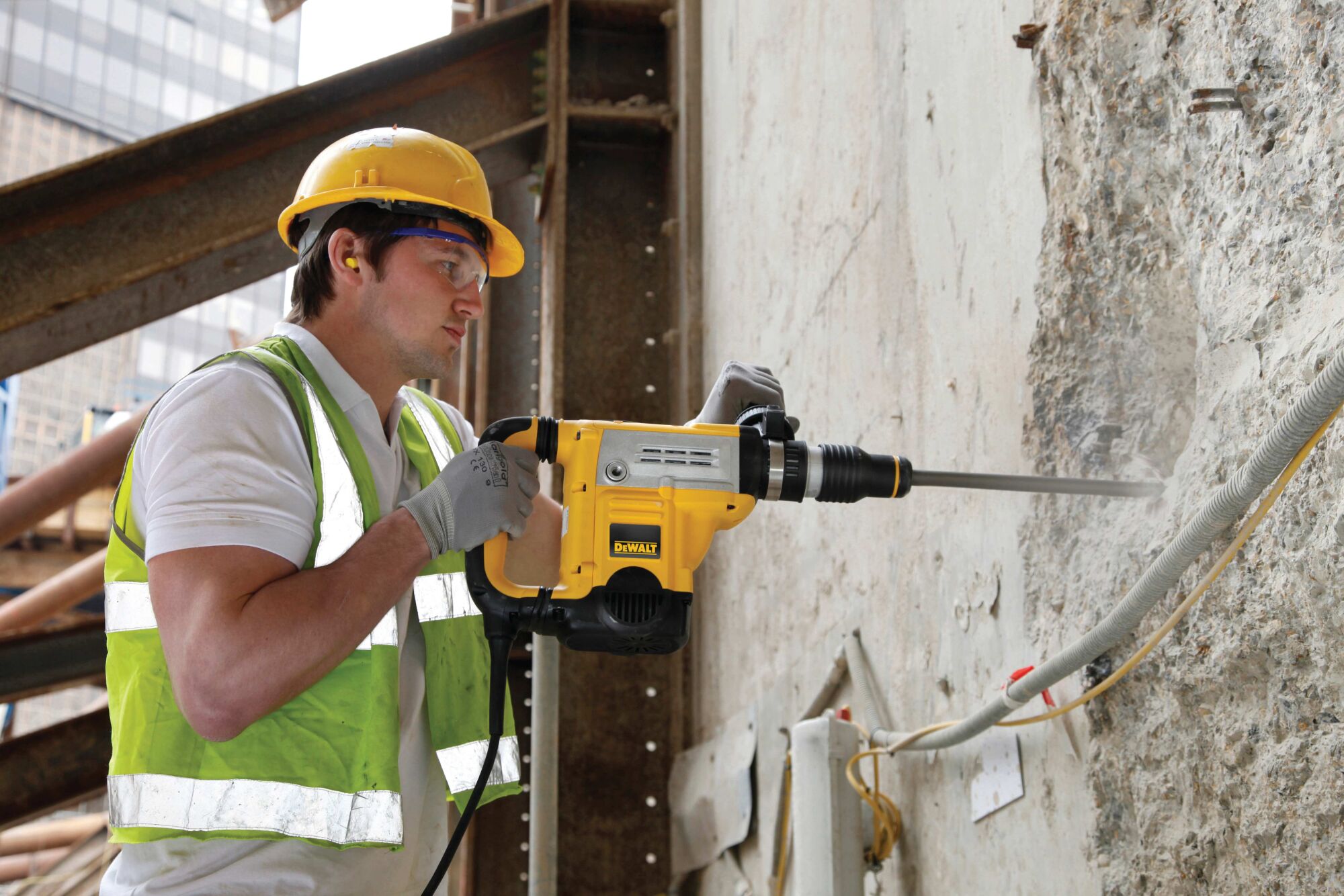
Vibrations
 |
 |
VIBRATIONS INFORMATION
DEWALT 's range of Power Tools offer leading vibration levels. DEWALT continues to use innovative technologies to continuously reduce the vibration to which workers are exposed.
WHO IS AT RISK?
Those who regularly operate high vibration equipment over long periods of time.
CONTROLLING THE RISKS
The risks can be controlled by good management such as using the correct tool for the job. This requires employers to carry out various duties including:
- Reducing exposure to a minimum
- Providing information and training
- Assessing exposure levels
- Carrying out measurements and reducing exposure, as well as providing health surveillance when the 'Exposure Action Value' has been reached
- Keeping exposure below 'Exposure Action Value' limit
VIBRATIONS MEASUREMENT
Vibration of handheld electric power tools is measured in accordance to EN 60745 series
EN 60745 which measures vibration in three directions (otherwise known as a tri-axial or vector sum measurement). This has been developed to replace the older version of EN 60745 standard and bring the manufacturers vibration measurement procedures in line with the HAV Directive.

m/s² = √ X² + Y² + Z²
MANUFACTURERS MEASUREMENTS
In reality there are far too many variables which can affect the outcome of the measurement. The DEWALT view is that job site measurement is too UNRELIABLE. DEWALT recommends that manufacturers values are used for calculating HAV exposure levels providing they are specifically identified as ‘Tri-Axial’ or ‘Estimated Tri-Axial’ according to HSE guidelines and EN 60745-1:2006 and reflect vibration values in the so called upper quartile.
VIBRATIONS EXPOSURE LIMITS
Exposure limits are calculated as a combination of the vibration level (magnitude) of the tool and the Daily Exposure Time (Trigger Time). E.g. A product with 5m/s² vibration can be used up to 2 hours/day to reach the EAV and up to 8 hours/day to reach the ELV.
Exposure Action Value (EAV) - Daily vibration exposure A(8) = 2.5m/s²
Where daily vibration exposure A(8) is below 2.5m/s² the risk is relatively low and no action need be taken
Exposure Limit Value (ELV) - Daily Vibration Exposure A(8) = 5.0m/s²
If several tools are use the exposure values must be combined:
Total exposure is then the combined value of the activities
ACTIONS YOU SHOULD TAKE
ACTIONS FOR WORKERS
- Report any signs of HAV – pins and needles, pain, numbness of the fingertips, pain in the wrists, reduced sensitivity in the touch
- Use the correct tools for the job
- Consider alternatives for completing the job or rotate with someone else where possible
- Use gloves
ACTIONS FOR EMPLOYERS
- Provide training and information
- Advise employees on safe working practices
- Eliminate or reduce vibration risks
- Regularly assess any vibration risks
- Supply suitable safety equipment
- Provide the right tools for the job
- Seek Health & Safety advice
FAQs
Vibration transmitted to hand and arm causing conditions such as:
- Vibration White Finger
- Carpal tunnel syndrome
- Disorders of bones, muscles, joints and sensory nerves
Effects:
- Finger blanching
- Loss of sense of touch
- Numbness and tingling
- Ability to grip
- Regular and frequent exposure to high levels of vibration can lead to permanent injury.
- This is most likely when contact with a vibrating tool or process is a regular part of a person’s job. Occasional exposure is unlikely to cause injury, although it should be avoided by people with medical conditions such as Raynaud’s Disease.
There are hundreds of different types of tools and equipment which can expose operators to high levels of hand-arm vibration. Some of the more common ones are:
- Chainsaws;
- concrete breakers/road drills;
- hammer drills;
- hand-held grinders;
- hand-held sanders;
- nut runners;
- pedestal grinders;
- power hammers and chisels;
- powered lawnmowers;
- riveting hammers and bolsters;
- strimmers/brush cutters;
- swaging machines.
Equipment manufacturers are generally trying to improve the vibration performance of their products, so new tools and machines are likely to emit lower vibration than older equipment. You will gain the maximum benefit from these improvements if you introduce a policy of buying the most suitable equipment when you replace tools or machines. DEWALT prides itself on innovation, and there for its range of hammers and other high risk products are some of the most up to date products on the market. Focusing on combating vibration at source (active vibration Control), DEWALT’s range of products demonstrate some of the loest vibration figures on the market.
For most types of equipment, manufacturers are required by law to:
- Design and construct equipment which will cause the minimum risk of vibration injury;
- provide you with warning of any residual risks from vibration;
- provide you with information on vibration levels;
- provide you with instructions on how to use the equipment to avoid risks from vibration.
You should:
- assess the risk to the health of your employees and plan for its control;
- manage the risk;
- provide suitable equipment for your employees’ use;
- maintain equipment correctly;
- give your employees information and training on health risks and safe use of the equipment;
- provide health surveillance of your employees where risks cannot be completely eliminated;
- provide reports to the relevant enforcing authority on cases of HAVS in your workforce;
- consult your safety or employee representative on your proposals to deal with vibration hazards.
The documentation supplied by the equipment manufacturer should warn you of risks from vibration. You can also check yourself to see if hand-held power tools, hand-guided and hand-fed machines are regularly used, and if so, whether anyone is, in particular using vibrating tools each day. If so, your employees are probably at risk. Even where employees are using vibrating tools or machines for less than these times, there may still be a risk and you should regularly (at least every six months) ask them if they are getting any symptoms of HAVS. Some simple questions you could ask are:
- Have your fingers gone white on exposure to cold?
- Have you had any tingling or numbness in your fingers after using vibrating equipment?
- Are you experiencing any problems with muscles or joints in your hands or arms?
- Do you have any difficulty picking up small objects such as screws or nails?
- If the answer to any of these questions is ‘yes’, assume that there is a risk from HAV to your employees. You should refer the employee to a doctor and take action to reduce exposure.
- There is more detailed guidance on what you can do to assess the risk in HSE’s publication Hand-arm vibration
There are many things you can do, several of which may cost very little and could also improve productivity and product quality, for example:
- Look for alternative ways of working which eliminate the vibrating equipment altogether.
- Make sure your employees use the most appropriate equipment for each job (inappropriate equipment may take longer to do the job or vibrate more).
- Minimise the time individuals use the equipment, eg job rotation.
- Break up periods of continuous equipment use by individuals (introduce other tasks).
- Design the job so that poor posture (which may cause strain on hands and arms) is avoided.
- Construct jigs to hold materials or tools.
Maintain tools to the manufacturer’s specifications to avoid worsening vibration. For example:
- replace vibration mounts before they are worn out;
- ensure rotating parts are checked for balance and replace them if necessary;
- keep tools sharp.
- Get advice from your trade association on best practice.
- Get advice from the equipment manufacturer on safe use of the equipment.
- Introduce a purchasing policy specifying low vibration performance for new equipment (see ‘Buying new equipment - some useful tips’).
- Mechanise or automate the work or change the way of working.
- Ask the manufacturer to add anti-vibration mounts to isolate the operator from the vibration source.
- Provide tool support to take the weight of the tool (eg tensioners or balancers) allowing the operator to reduce grip and feed force.
Employees need to know about the hazard and what they should do to reduce the risk, for example:
- potential sources of hand-arm vibration;
- the health effects of hand-arm vibration;
- risk factors (eg high levels of vibration, daily length/regularity of exposure);
- how to recognise and report signs of injury;
- ways to minimise risk, including:
- changes to working practices to reduce vibration exposure;
- correct selection, use and maintenance of equipment;
- how to use tools to reduce grip force, strain etc;
- maintenance of good blood circulation at work, eg by keeping warm, exercising fingers and not smoking.
You should consult with your safety or employee representative on your proposals for training and information.
Legislation:
- Where there is a risk of vibration exposure it requires employers to:
- Assess exposure levels
- Reduce exposure to a minimum
- Provide information and training
- Program of health checks and reduced exposure
- 25 million people at risk
- Over 5 million exposed to dangerous levels of HAV
- 1 million people suffering from advanced symptoms
- Annual cost to UK economy over €500 million
- Annual cost to European economy €5 Billion
Aims to reduce the amount of injuries caused by over exposure to high levels of vibration due to excessive use of power tools.
- Metal fabrication workers
- Maintenance fitters
- Carpenters and joiners
- Electricians
- Plumbers
- Builders and construction workers
Through establishing allowable usage levels depending on vibration of machine.
Vibration is measured in: m/s²
Exposure Action Value (EAV) < 2.5m/s² Daily Exposure
SAFE USAGE
Exposure Limit Value (ELV)=< 5m/s² Daily Exposure
ASSESSMENT REQUIRED
Exposure Limit Value (ELV)=> 5m/s² Daily Exposure (ELV)
The usage time is limited depending on the level of vibration

m/s² = √ X² + Y² + Z²
Vector sum of X,Y & Z
2002/44/EC Requires this Standard